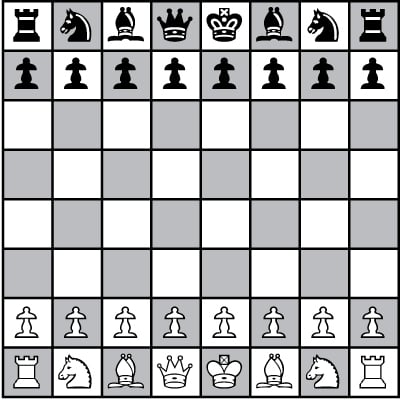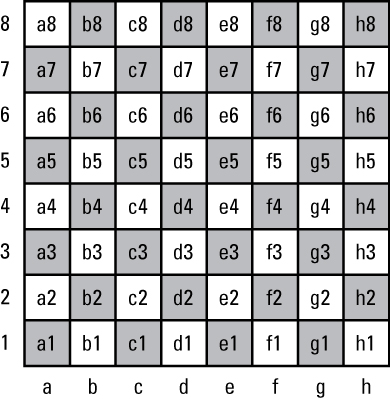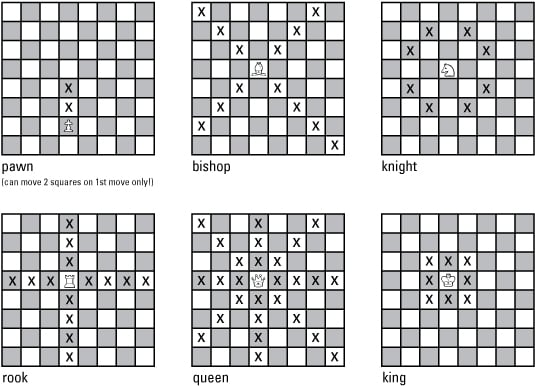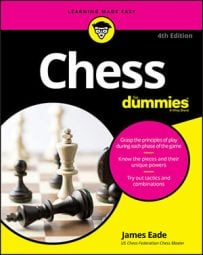Setting up your chessboard
Setting up your chessboard is the first step in playing a game of chess. Take your time setting up the board until you’re confident that you know where everything goes:
-
Set the rooks (the pieces that typically look like tiny castle towers) on the corner squares.
-
Place the knights (typically horse-like pieces) next to the rooks.
-
Put the bishops (pieces that are typically topped with a teardrop shape) on the board next to the knights.
-
After the bishops come the queens, usually recognizable by a small crown near the top of the piece. The queens always start on the square of the same shade — the white queen starts on a light square, and the black queen starts on a dark square.
-
Place the kings next to the queens, which is only fitting. These pieces typically have a tiny cross at their top.
-
Add the pawns (the smallest and shortest pieces) straight across the rank in front of the other pieces.

Naming ranks and files in chess
The chessboard is divided into ranks (numbers) and files (letters). This is used as an identifier for when the players move their chess pieces. There are eight of each, and each is comprised of eight squares of equal size:
-
Ranks are rows that go from side to side across the chessboard and are referred to by numbers. Each chessboard has eight ranks, which are numbered from the bottom of the board (where the white pieces start) on up.
-
Files are columns that go up and down the chessboard, and, since boards are square, each board also has eight of them. Because numbers indicate ranks, letters indicate files, which are labeled from left to right.
-
The naming conventions for ranks and files allows you to give an identifier to every square by using what chess people call the file-first method. For example, the lower right-hand square is called h1. This name is shorthand for h-file, first rank.

Knowing the moves that chess pieces can make
Before you can play a game of chess, you need to know how to move the pieces (legally). A chess piece’s power is tied to its mobility. The more mobile a piece is, the more powerful it is:
-
Pawns: Pawns can only move forward. On their first move, they can move one or two squares. Afterwards, they can move only one square at a time. They can capture an enemy piece by moving one square forward diagonally.
-
Bishops: Bishops can move any number of squares diagonally.
-
Knights: Knights can move only in an L-shape, one square up and two over, or two squares over and one down, or any such combination of one-two or two-one movements in any direction.
-
Rooks: Rooks can move any number of squares, up and down and side to side.
-
Queens: Queens can move any number of squares along ranks, files and diagonals.
-
Kings: Kings can move one square at a time in any direction.

Understanding check, checkmate, and stalemate in chess
In chess, check is an attack on an enemy king; this attack can’t be ignored. If the check can’t be neutralized, it is checkmate and the game is over. Stalemate occurs when one player has no legal moves, but his king isn’t in check. Here are a few additional details on check, checkmate, and stalemate in chess:
-
Check: An attack on a king by either an opposing piece or an opposing pawn is called check. When in check, a player must do one of the following:
-
Move the king so that it’s no longer under attack.
-
Block the attack by placing a piece between the king and the attacker.
-
Capture the attacking piece.
-
-
Checkmate: When a king is in check and can’t perform any of the preceding moves, it has been checkmated. If your king is checkmated, you lose the game. The term checkmate is commonly shortened to simply mate.
-
Stalemate: Stalemate is the relatively rare situation when a player whose king isn’t in check has no legal move to make. Stalemate is considered a draw. Neither player wins, but the game is over.

